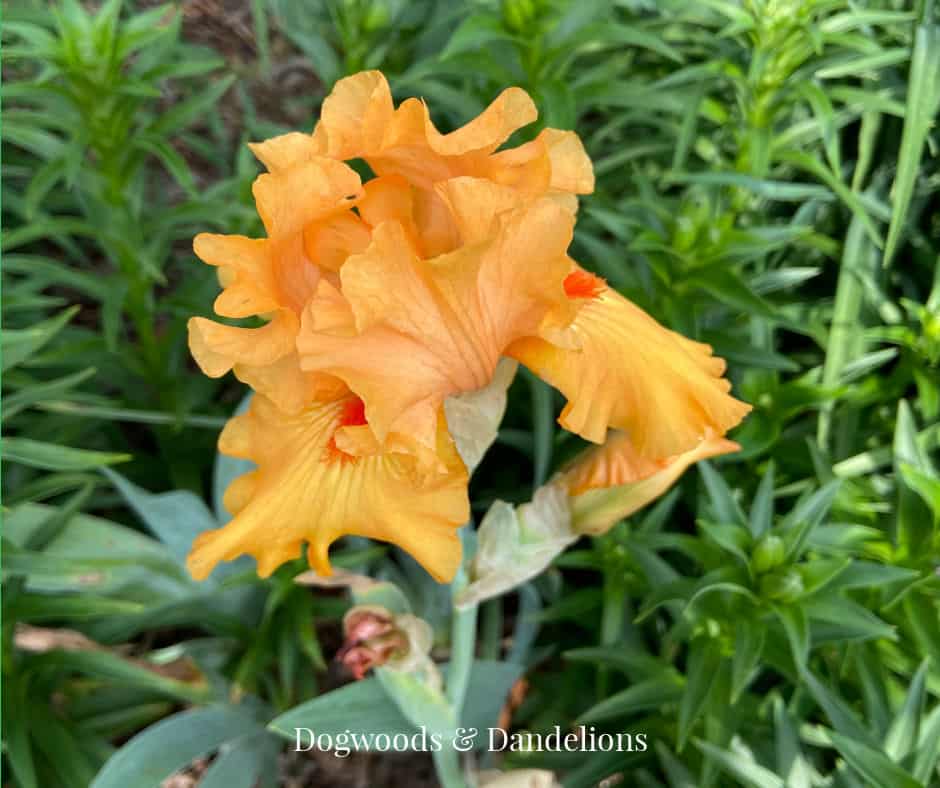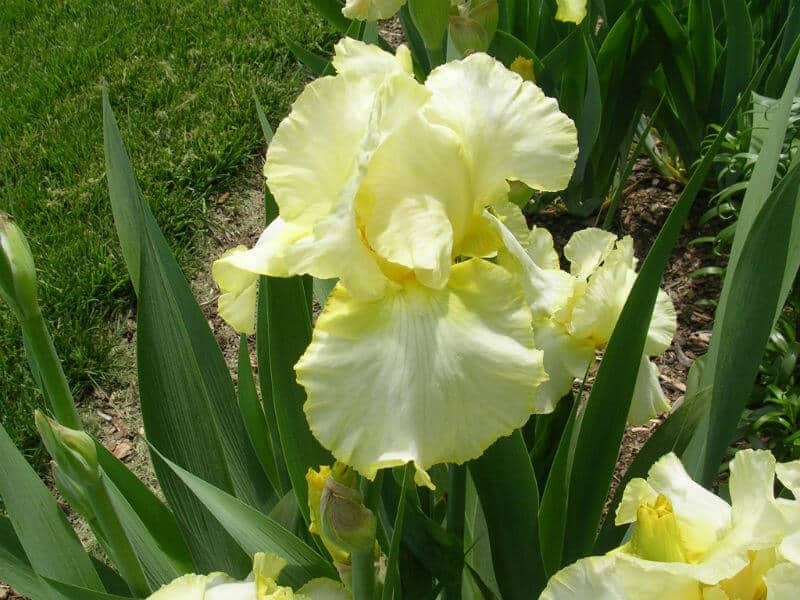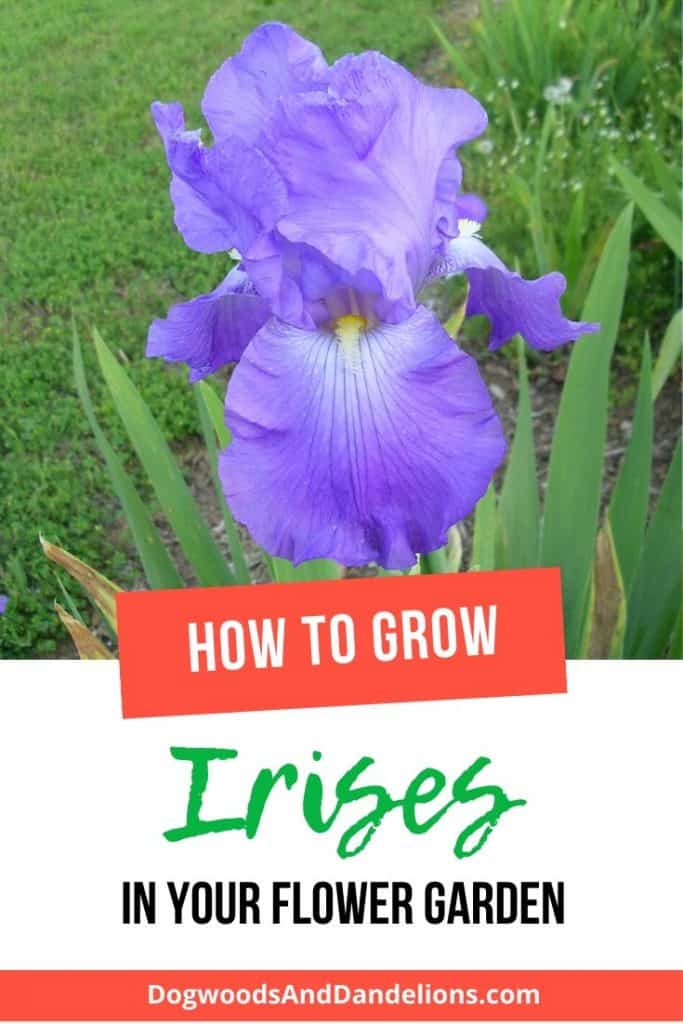How to Grow Irises
Inside: Learn how to grow irises in your garden and the many reasons you might want to add irises to your flower beds.
How (& Why) You Might Want to Grow Irises
Why should you grow irises? For starters, they are an easy-to-grow flower that comes back every year. They will grow in almost any part of the US. The flowers are great for attracting hummingbirds and butterflies.
Irises also make beautiful cut flowers. You plant them once and each year they will give you gorgeous color in your flower garden.
They come in a multitude of colors and are very hardy. Actually, the word “Iris” comes from the Greek word for rainbow which is especially fitting since they come in a rainbow of colors.
Irises make a great plant for the back of a flowering border, but usually shouldn’t be planted near the front of a bed since most varieties grow at least a foot tall.
There are many different types of irises, such as Dutch irises (Iris hollandica), Japanese iris (Iris ensata), Siberian irises (Iris siberica), and bearded irises (Iris germanica). However, most new irises are planted the same way.

Affiliate Disclosure: Please note that some of the links in this article may be affiliate links and I may receive a small commission if you purchase something through a link. It will not change your cost. As an Amazon Associate, I earn from qualifying purchases. For more information, see my disclosures page.)
(This article was co-written with my sister, Robin Armstrong.)
How to Grow Irises
Irises aren’t difficult to grow. They grow well in sunny locations in zones 3 – 9. However, there are a few things to consider when planting your irises to ensure they bloom well for years to come.
When you purchase your irises, they will most likely come looking like a potato tuber. This tuber is called a rhizome. The roots and leaves are usually clipped before shipping.
You can leave the iris tuber out for a week or two, though the sooner it is planted the better. Store the rhizomes in a cool place until you are ready to plant.
Occasionally, if you purchase irises locally, you may find them already potted with leaves and roots still intact. The same planting instructions still apply.
Sunlight
Irises grow best in full sun; they need a sunny spot with at least 6 hours of sunlight a day to bloom well.
Soil Conditions
It is essential to grow irises in well-drained soil. If iris plants sit in water, the roots will rot.
With some soil types such as heavy or clay soils, adding compost, gypsum, or soil conditioner (such as fine pine bark) will help ensure good drainage. Iris can also be planted in a raised bed, allowing the soil to drain better.

Prepare Your Planting Area

The best time to plant bareroot plants is late summer to early fall – July through September. However, you must water well. Many people find success planting irises in early spring also.
Prepare your soil by removing any grass or weeds and tilling or digging the soil to loosen.
Dig a wide, shallow hole, with a small mound of soil mixed with organic material in the bottom. Place the rhizomes (the swollen root) on the mound in the planting hole, and firmly pack the soil around it until only the tops of the rhizomes are visible.
Water plants gently, immediately after planting, then every week for the next month. Be sure not to overwater and take into consideration any rain you may have received.
When growing multiple irises plant rhizomes 6 -12 inches apart.
Watering
Irises are very drought tolerant, but grow and bloom best with a half inch or more of rainfall a week. A common mistake when growing irises is to give them too much water.
Fertilizing Irises
Fertilize twice each year in late winter or early spring (around March 1) and again around August 15.
Use a low-nitrogen fertilizer, such as 5-20-20 or 5-20-10. Too much nitrogen will produce lots of iris leaves but not many iris flowers and can lead the roots to rot.
Every two or three years, use a complete fertilizer that contains minor and micronutrients.

How to Care for Irises
After spring bloom, cut down the bloom stalks. If not, they can produce seed pods, which will not grow the same as the parent plant.
Remove any leaves that turn brown during the growing season and all brown iris foliage in the fall. This will keep insects from overwintering in the dead leaves.
Every three or four years, it is best to dig up the entire clump in late summer and divide the plants. To divide irises, use a sharp knife to cut the new rhizomes apart from the old.
You can then replant each section or give some away to friends. Remember to space plants 6 to 12 inches apart when replanting.
Reblooming Irises
Some varieties have the ability to bloom a second time in the summer or fall. Though rebloom is not guaranteed, it is often affected by weather conditions.
With reblooming varieties, summer rainfall or supplemental watering will increase fall bloom.
A Few Notes on Growing Irises

While it is best to plant irises July through September, they can be planted any time as long as you can dig a proper hole. (Don’t try planting them in frozen ground.)
There are so many types of iris and iris colors there is sure to be one just for you. Are you looking to purchase some Irises for your landscape? If so, check out Pecan Grove Farms on Etsy. (Full disclosure…this is my sister’s shop, however, I am not receiving any compensation for this post.)
For more information on growing irises, iris lovers will want to check out The American Iris Society.
Do you grow flowers in your yard? Have you ever grown Irises before? If you’ve grown them before, what is your favorite variety?
Related Posts
- How to Grow Coral Bells
- Learn How to Collect & Save Zinnia Seeds
- Growing Flowers in the Vegetable Garden

Meet Julie
I’m a farm girl born and bred in North Carolina. I’ve been growing a vegetable garden for over 20 years (and helping my Mom grow hers even longer). I’ve been raising chickens in my bathtub and backyard for 12+ years. I believe that homegrown food can be made simple. Let’s get started.



Hey that’s for the information. So once they bloom and you cut the stalk does it mean that particular one won’t bloom again? Or it still does?
The remaining blooms on the stalk will still open. If there are other stalks for the same plant, they will bloom also.
Can you grow them in pots?
Yes, you can grow irises in pots, however it can be a little tricky. They need a fairly large pot since the rhizomes spread and they need soil that drains really well.
Hi Julia,
Thanks so much for the informative post. I have just planted some deep purple irises in my garden that I inherited from a friend. We are heading to autumn now in South Africa but they have settled and are growing well. I am so looking forward to their blooms in spring which is in August for us.
Lucienne
I bet your irises will be beautiful. Thanks for commenting.
Julia,
Her yard is always so pretty!!! I love the ‘Helen Collingwood’ Purple and White Tall Bearded Iris…. the deep purple color is spectacular!!! They are all beautiful!! I’m partial to the purple. ?
I know the purple has special meaning to you!
This is a great article Julia. I have lots of iris that never bloom and plan to use some of your tips! Also am signing up for “free goodies” , whatever they may be! Thanks fortheinfo.
I’m glad the info was helpful. Good luck with your irises this year!
This is a great article Julia. I have lots of iris that never bloom and plan to use some of your tips! Also am signing up for “free goodies” , whatever they may be! Thanks fortheinfo.
Wow – how cool. I did not know she sold her flowers. I liked the Nut and Honey Maroon and really all of them. They are all pretty in her yard.
Thanks Risa! Her yard is always so pretty.